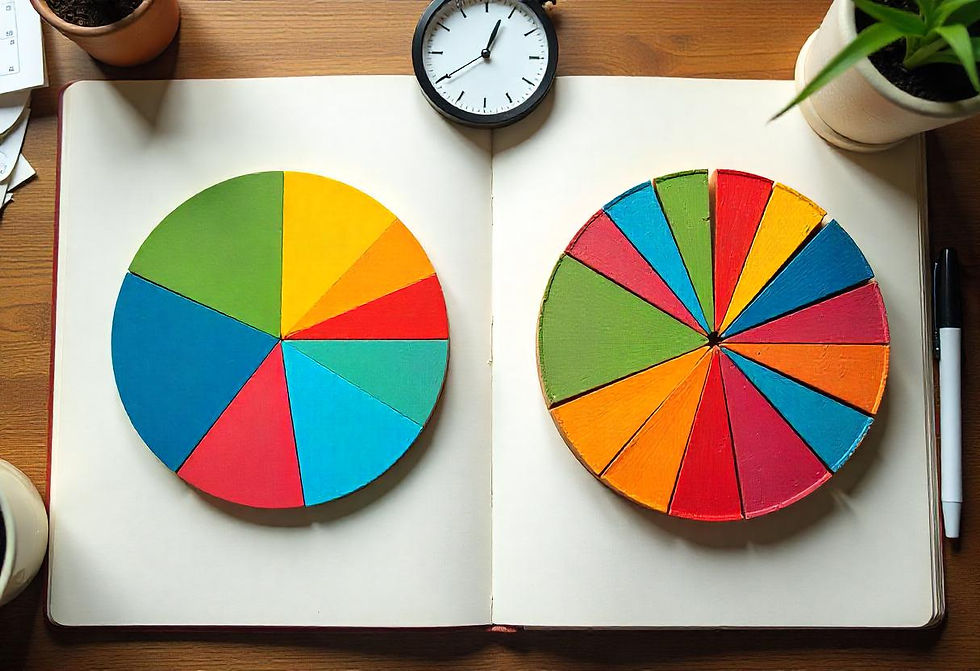How to Conduct a Personal Time Audit and Find Hidden Hours
- MindSpaceX

- Aug 9
- 5 min read

The average person will spend 33 years of their life in bed, 13 years at work, and nearly 8 years watching TV—yet 80% of us feel we "don't have enough time" for the things we truly value. The disconnect is startling.
Where does all your time really go? If you've ever reached the end of a day wondering what you actually accomplished, you're not alone. The gap between our perception of time spent and reality represents one of the most significant obstacles to personal productivity and fulfillment.
A personal time audit—a systematic analysis of how you actually spend your hours—might be the most revealing exercise you'll ever undertake. In this article, we'll explore how to conduct a comprehensive time audit, interpret your findings, and implement changes that can quite literally give you back hours of your life each week.
Background & Context:
The concept of time management dates back to the industrial revolution when factory owners sought to optimize worker productivity. However, the personal time audit as we know it today gained prominence in the 1970s with Alan Lakein's book "How to Get Control of Your Time and Your Life," which introduced the idea of analyzing time as a personal resource (Lakein, 1973).
Today's understanding of time management has evolved significantly. Rather than simply "managing time"—an impossible feat since time remains constant—modern approaches focus on managing attention, energy, and priorities within the time we have.
A personal time audit method involves tracking your activities, usually for a period of 1-2 weeks, categorizing how time is spent, and analyzing patterns to identify opportunities for improvement. Unlike corporate time studies designed to increase worker output, a personal time audit aims to align your time allocation with your values and goals.
Expert Analysis & Insights:
Research from Harvard Business School found that knowledge workers typically spend only 26% of their workday on the tasks they identify as most important (Keller & Papasan, 2013). The remainder gets consumed by low-value activities, interruptions, and administrative tasks.
Dr. Laura Vanderkam, time management expert and author of "168 Hours," conducted studies with busy professionals and discovered that people routinely overestimate work time by 5-10 hours per week while underestimating leisure time by a similar amount (Vanderkam, 2010). This perception gap fuels the feeling of time scarcity that many experience.
"The fundamental problem isn't lack of time," explains productivity researcher Dr. Cal Newport. "It's lack of awareness about where time actually goes, combined with the absence of intentionality in time allocation" (Newport, 2016).
A 2019 study published in the Journal of Personality and Social Psychology found that time auditing leads to higher productivity and greater life satisfaction. Participants who conducted weekly time audits reported 23% higher fulfillment scores and demonstrated measurable productivity increases of 18% compared to control groups (Whillans et al., 2019).
Real-World Examples:
Emily Thompson, CEO of a marketing agency, discovered through her time audit that she was spending nearly 15 hours weekly on email—almost two full workdays. By implementing batched email processing twice daily, she reclaimed 10 of those hours for strategic work and business development, ultimately growing revenue by 34% within six months.
Software engineer Marcus Chen used a personal time audit to identify that his productivity collapsed after 3 PM daily. By restructuring his schedule to place deep work in the morning hours and meetings/administrative tasks in the afternoon, he completed a major project two weeks ahead of schedule.
The technique works across industries and roles. Healthcare professionals have used time audits to reduce administrative burden and increase patient care time. Teachers have applied the method to balance grading, preparation, and instructional time more effectively. Even parents have used time audits to identify opportunities for more quality family engagement.
Alternative Perspectives:
Critics of time auditing argue that the practice can lead to over-optimization and a mechanical view of life. Psychologist Dr. Sandi Mann cautions, "There's a risk of turning every moment into a productivity equation, which can increase anxiety rather than well-being" (Mann, 2018).
Some time management skeptics suggest that the very focus on productivity represents a capitalist mindset that devalues rest and contemplation. However, proponents counter that a properly conducted time audit actually helps people protect time for rest, relationships, and personal interests that would otherwise be consumed by work and digital distraction.
Data from a 2020 Stanford University study indicates that the effectiveness of time auditing varies by personality type. While structured personalities saw significant benefits, those scoring high on spontaneity traits sometimes experienced increased stress when attempting rigid time tracking (Goldsmith & Reiter, 2020).
Practical Takeaways & Future Outlook:
The 4-Step Personal Time Audit Method:
Track Your Time: For at least 7 consecutive days, record your activities in 15 or 30-minute increments. Digital tools like Toggl, RescueTime, or even a simple spreadsheet can help. The key is accuracy—log what you actually do, not what you planned to do.
Categorize Your Activities: Group activities into categories that make sense for your life: work, sleep, exercise, family time, social media, household tasks, etc. Calculate total hours in each category.
Analyze Patterns: Identify your peak productivity hours, time drains, and misalignments between how you spend time and what you value. Look for surprises—the data often reveals patterns we're unaware of.
Redesign Your Time: Based on your findings, create a realistic template for how you want to allocate your time. Focus on small, sustainable changes rather than complete overhauls.
Future developments in time management suggest a growing integration between time tracking and biometric data. Wearable technology can now correlate energy levels, focus, and cognitive performance with specific times of day, enabling more personalized productivity strategies.
Dr. Elizabeth Grace Saunders, time management coach and author, predicts: "The next frontier will be AI-assisted time auditing that provides real-time guidance on optimal activity selection based on your goals, energy levels, and past performance patterns" (Saunders, 2021).
There You Have It…
A personal time audit isn't just about finding productivity hacks—it's about reclaiming ownership of your most finite resource. By understanding where your hours truly go, you can make conscious decisions that align your time with your values and priorities.
The most powerful outcome of a time audit isn't necessarily working more efficiently—it's the clarity that comes from seeing the gap between how you think you spend your time and how you actually spend it. This awareness alone can transform how you approach each day.
What hidden hours will you discover in your own life? And more importantly, what will you do with them once you find them?
For more detailed guides on time auditing techniques, productivity systems, and mindfulness practices that complement effective time management, visit us at MindSpaceX.com.
REFERENCES:
Keller, G., & Papasan, J. (2013). The ONE Thing: The Surprisingly Simple Truth Behind Extraordinary Results. Bard Press.
Lakein, A. (1973). How to Get Control of Your Time and Your Life. New American Library.
Mann, S. (2018). The Upside of Downtime: Why Boredom Is Good. Robinson Publishing.
Newport, C. (2016). Deep Work: Rules for Focused Success in a Distracted World. Grand Central Publishing.
Saunders, E. G. (2021). Divine Time Management. FaithWords.
Vanderkam, L. (2010). 168 Hours: You Have More Time Than You Think. Portfolio.
Whillans, A., Giurge, L., & West, C. (2019). Why time poverty matters for individuals, organisations and nations. Nature Human Behaviour, 3(10), 1041-1049.
Goldsmith, M., & Reiter, M. (2020). The Earned Life: Lose Regret, Choose Fulfillment. Currency Publishers.
.png)














Comments